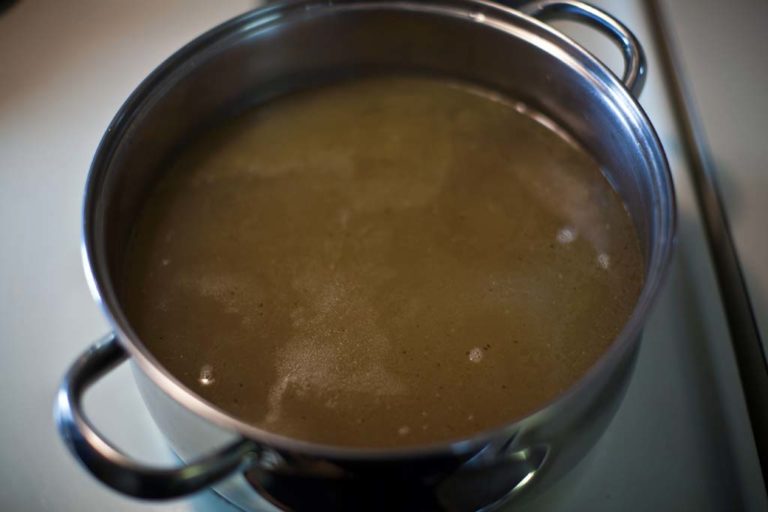
Chef's notes:
Traditionally, stock is made from food not desired for consumption in its current, more complex form. Bones, cartilage, feet, joints and skin are the most common items used to make animal-based stock. A broth is similar to stock, but the name “broth” usually implies that it was made with fresh meat and that it is seasoned in such a way that it could be consumed on its own. Stock is not prepared in this way. It is itself a raw ingredient in cooking, from which broth could be made.
Making stock from poultry is quite popular and is perhaps easier than making stock from other animals. Poultry bones, joints and skin have lots of collagen in them, which, when simmered for 4-5 hours with vegetables and herbs, will be released into the water, thickening it. Collagen is only one tiny step away from becoming gelatin, and hence has many of its characteristics. The result is a thickened, flavorful liquid that can be used to make hundreds of sauces, soups, stews, braised dishes and gravies.
Ingredients
- Leftover turkey carcass with bones, skin, cartilage and little meat.
- 5-6 whole carrots
- 3 onions
- 3-4 ribs celery
- 1-2 sprigs thyme
- 6 sprigs parsley
- 2 bay leaves
Homemade Turkey Stock Recipe Using Leftover Turkey Carcass, Carrots, Onions, Celery, and Herbs
- Divide your leftover turkey into two piles: meat and scraps. It will not be necessary to use the meat to make stock; the bones, skin and cartilage will be sufficient. Boiling the meat would just be wasteful, and it could also cloud the stock. So reserve the edible meat for a soup at another time. Put the bones and things in a 5-6 quart stock pot and cover them with water. Begin simmering the bones until you see a scum rise to the top. Skim that scum off, continue simmering, and move on to the next step.
- Proper stock requires a mix of vegetables and herbs known as mirepoix and bouquet garni. Mirepoix is a classic French combination of three vegetables: onion, celery and carrot. For the purpose of making stock, fresh vegetables are not completely necessary. For example, I am using old, limp carrots and the leafy tops of celery. Bouquet garni is thyme, parsley and bay leaves bound together with butcher’s twine so the bundle can be easily removed from the pot.
- Add the vegetables to the pot only after skimming off the scum from the bones. Keeping the vegetables whole is to keep the stock clear. Diced vegetables will become very mushy, especially the carrots, and become a puree in 4-5 hours of simmering. On the other hand, whole vegetables will only just begin to break up after 5 hours. Especially if you refrain from stirring, which you shall. Simply wash the carrots and celery. Cut off the ends of the carrot, and peel the outer layer of skin off the onions.
- As the mixture simmers, keep skimming off fat. You will know the mixture has resumed an extremely gentle simmer once the liquid is moving from the bottom to the top, but not violently breaking the surface. When this happens, cover the mixture and lower the heat; a covered pot does not require as much heat to boil. Every 20-30 minutes, remove the lid and scoop off the fat and scummy stuff floating on the top.
- After four hours of cooking, taste the stock. It will be difficult, without salt, to taste it, but you should be able to get an idea of how concentrated the flavor is. Look at the color of the stock as you taste. If you need to add a little salt to be able to taste it, be careful not to over-salt it. If your stock is ready to be strained, use a spoon to get out the big chunks first, and then pour the rest through a fine mesh strainer or a piece of cheesecloth. Cool the stock by putting the pot in a sink of ice water and stirring the stock.
Tips & Tricks
- The nice thing about bouquet garni is it makes it easier to find the bay leaf. Traditionally, it is made with parsley, thyme and bay leaf. But some other herbs are often used, depending on the situation. Basil, celery, chervil, tarragon, rosemary and savory are popular.
- To tie a bouquet garni, grab all the herbs at the base and hold them tightly. Use a short piece of butcher’s twine and wrap it around once and tie a square knot to cinch it up. Wrap it around again and tie a double square knot. Trim the ends.
